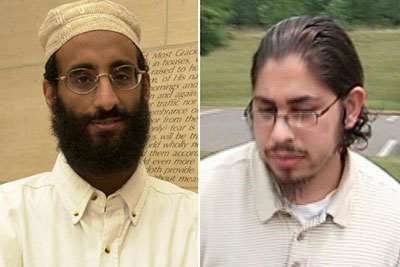
Anwar al-Awlaki, left, an operative in Al Qaeda’s Yemeni branch, was targeted in a strike that also killed Samir Khan, the creative force at a militant Web magazine. Both were Americans; Left, Linda Spillers for The New York Times; right, WBTV, via Associated Press
Today’s New York Times features a major article by MARK MAZZETTI, CHARLIE SAVAGE and SCOTT SHANE entitled “How a U.S. Citizen Came to Be in America’s Cross Hairs.” Actually the article discusses how three American citizens were the victims of drone attacks in Yemen in late 2011. The primary target was Anwar al-Awlaqi, who is described in the article as “the firebrand preacher, born in New Mexico, who had evolved from a peddler of Internet hatred to a senior operative in Al Qaeda’s branch in Yemen.” He was a socially mediated firebrand, far better known for his English than having an impact on recruiting terrorists in Yemen. Killed in the same after-breakfast attack was Samir Khan, “the creative force behind Inspire, the militant group’s English-language Internet magazine” and someone (basically a propaganda journalist) who was not considered important enough to specifically target. The article continues: “The next month, another drone strike mistakenly killed Mr. Awlaki’s 16-year-old son, Abdulrahman, who had set off into the Yemeni desert in search of his father. Within just two weeks, the American government had killed three of its own citizens in Yemen. Only one had been killed on purpose.” The 16-year old fell victim to a botched targeting:
Then, on Oct. 14, a missile apparently intended for an Egyptian Qaeda operative, Ibrahim al-Banna, hit a modest outdoor eating place in Shabwa. The intelligence was bad: Mr. Banna was not there, and among about a dozen men killed was the young Abdulrahman al-Awlaki, who had no connection to terrorism and would never have been deliberately targeted.
The drone issue has recently resurfaced, most notably in Mr-Rand-Paul-goes-to-Washington’s 13 hour filibuster. This was due in large part because of the issue of how far an American president can go to kill American citizens without a trial. The lengthy NYT article traces the evolution of intelligence gathering that led to the targeting of al-Awlaqi, including the email exchanges with Major Nidal Hasan and coaching of the potentially explosive underwear bomber. Now the makings of a spy thriller emerge. Salafi moles were employed to get close to al-Awlaqi. For example, why not take advantage of Muslim polygyny:
In its most exotic effort to track the cleric, the C.I.A. worked with Danish intelligence to use Morten Storm, a Danish convert who had befriended Mr. Awlaki, to put a tracking device on the suitcase of a woman who had agreed to become the cleric’s third wife. The plan failed when Mr. Awlaki’s wary associates discarded the suitcase. But Mr. Storm also told the authorities that he communicated with Mr. Awlaki via a courier; it is not clear whether that courier eventually helped lead the C.I.A. to Mr. Awlaki’s location.
From a military standpoint it is obvious that drones are here to stay. We have come a long way from medieval carrier pigeons and the helium balloons hovering over World War I battlefields. We do not live in Dr. Pangloss’s best of all possible worlds, nor even More a modern-day Utopia. Suicide bombs and cluster bombs both rip through bodies, cars can be blown sky high and buildings can be leveled. The suffering from terrorism, whether by extremists outside of state control or states targeting suspected extremists, is all too real. So the scenario exists that an individual citizen intent on killing others for whatever the cause should be killed to prevent the greater loss of life. Police deal with this problem every day. Had a U.S. Air Force jet shot down the hijacked flight minutes before it smashed into the World Trade Center, would that not have been justifiable in hindsight? Such an ethically daunting scenario is fortunately rare indeed, but the likelihood increases with every new technological innovation.
In dealing with “terrorists,” effective intelligence is essential. The 16-year-old son of Anwar al-Awlaqi, an American citizen living in Yemen, died for not only his father’s sins but as collateral damage in the most unfriendly of fire. Many other Yemeni youth and children and women have also died for being in the way of terrorist targeting. This is not some video game where the game can be started over and victims get back up to be shot again and again. The dead stay dead, no matter what the alibi. And the mutilated bodies of innocent victims are the best recruiting tools that terrorists have going for them.
There is always the danger that Big Brother is not only watching the “real terrorists” but may be watching you, as George Orwell suggested. In his secul-glaringly prophetic 1984 he also wrote:
“The object of terrorism is terrorism. The object of oppression is oppression. The object of torture is torture. The object of murder is murder. The object of power is power. Now do you begin to understand me?â€
This seems to be what motivated Rand Paul to avoid going to the senate men’s room for half a day. His speech is part of the checks-and-balances political system that we hate for its indecisiveness and bickering but appreciate for preventing any single political force from dominating. Before Orwell, my Italian ancestor Machiavelli made the same point: power is indeed all about power. Staying clear of the downside of power is one of the great dances of life. It seems we in the 21st century have yet to fully understand what is a powerful lesson of all history.